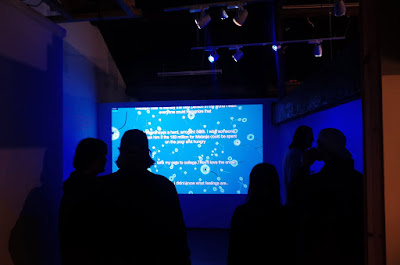We begin this post with a
slight sadness due to the closure of a gallery we’ve had both personal and
professional links with in the past – Limoncello #momentofsilence. A shame to
see a gallery that’s been going 10 years have to close its doors indefinitely,
they had some really great artists and the private views were saturated with
free drink (big up). A truly disheartening discovery on multiple levels.

Kate Owen’s show was on our
list of openings to attend this week but obviously there had to be a change of
plans. Carlos Ishikawa opened Tom
Worsfold’s solo show titled Apparition which
was a series of frenzied, maximal paintings that often featured everyday
scenes like haircuts and showers. We didn’t really have any way into this work –
it felt very one dimensional with very little context or meaning. It’s the sort
of work that when describing the inspiration, the artist might say ‘the work comes from observing everyday life scenes and
objects’, which is completely applicable and valid as an explanation but would
most likely be the extent of it. Perhaps this is too harsh of a judgement to
make without enough knowledge but on visiting his website to potentially find
such knowledge we learnt that there was no artist statement or anything else
that might point us in the right direction (not that uncommon or to be looked
at negatively but it didn’t assist in our search). Something we did find was
another painting that wasn’t shown titled Hangover
depicting an incredibly muscly pizza guy emerging into this dark room like a
God, which I can’t say supported the quest for meaning in his work. They also
managed to run out or beer?! (not a reflection on the art but merely an
observation – these things happen).

Auto-Italia
South-East also had an opening that we attended. Slight improvement on the
alcohol front being that that they actually had some. However, it was a quid for
a bottle pitching right in the middle of pub price and buying from a shop
price. They also had some art there which was a significant improvement (not
that it’s a competition). Feral Kin
is a new group exhibition project which has a few under underpinning themes
including symbiotic ecosystems, esoteric tools and the importance of group work.
We
also managed to see Gavin Turk at Damien Hirst’s Newport Street Gallery. The show
is very aptly named Who What When
Where How and Why and is a brilliant presentation of Turk’s work which
spans from him at art school all the way up to this year. The show features his
infamous degree show work which has become part of the Gavin Turk legend: the
provocative exhibiting of an empty studio containing just a blue ceramic
‘heritage’ plaque on the wall bearing Turk’s name and dates of occupancy. The story
that the RCA refused to give him his MA definitely gave him a leg up in into art
stardom. In Newport Street Gallery the little blue plaque again occupies an even
more extensive space and you are still intrigued by the notions of authenticity
and historical significance that he’s bringing into question.


On approaching
the end of the show we encounter some of our favourite works; the Trash Culture series in which he meticulously
remakes items of rubbish – bin bags, chip forks, takeaway cartons, polystyrene
cups – in cast, painted bronze. These bits of detritus, which are rendered
using the finest of traditional skills, litter the gallery floors and query the
art and life boundaries which seem almost non-existent here. Of course they are
also laden with multiple cultural references. A painted bronze pavement, pocked
with trompe l’oeil blobs of chewing gum is arranged in the format of a classic
Carl Andre minimal floor-piece (though you can’t walk on this one which is a
shame since it always felt like the perfect final touch to these practical
materials). The giant, shining, black painted-steel replica building skip, that
fills the final room, also pays homage to the Minimalist’s no-nonsense
utilitarian aesthetic, as well as tipping its hat to Marcel Duchamp, whose
urinal was also a container for waste. A big thumbscribe from us – keep doing
you Gavin.

Corvi
Mora is just around the corner so went in to check out Tomoaki Suzuki’s new
show. He’s created these life-like figures which combine traditional Japanese
woodcarving techniques with contemporary portraiture. Created in limewood at
roughly one third of human scale, these sculptures depict the artist’s friends
and acquaintances, as well as passers-by he encounters on the street near his
studio in Dalston. In the press release he characterises his process as
“obsessive”, saying that each sculpture begins with a series of fifteen to
twenty sittings, totalling thirty hours spent with his subject in the studio.
During this time, their conversation is as important to the artist as the
photographs he takes from every angle, which he then spends months translating
into drawings of each figure. From these drawings, he carves his portraits in
limewood before painting them by hand in acrylic. We weren’t totally convinced
by how the conversation would have influenced the final products but perhaps it’s
more to do with what the objects represent on an emotional level. Fascinated by
fashion and its signifiers of Western consumerism and multiculturalism, We saw
one of these at Frieze and there too it was displayed on the floor without a
plinth or protective barriers which feels like a very appropriate method of presentation;
allowing them to inhabit the viewer’s physical space and elicit our
identification and empathy.

































